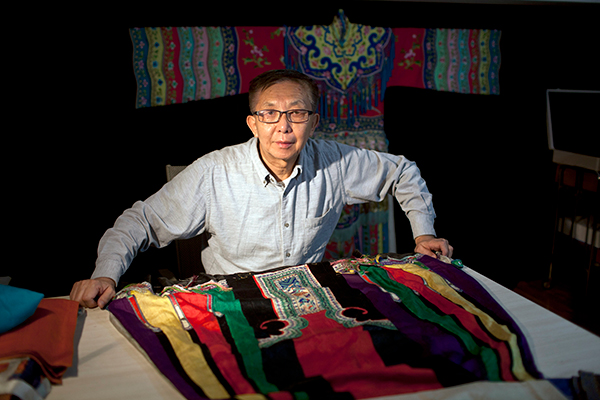Four colors
By Chen Nan | 中国日报网 | Updated: 2019-01-24 08:01

"I enjoy looking at the costumes as much as I enjoy seeing good photos. They are both works of art and powerful."
Chen exhibited some costumes from his collection in Macao in 2017, and last year, he showed some at Shanghai's Tongji University.
According to Lyu Guliang, director of the traditional Chinese opera committee under the China Association of Performing Arts Committee, which aims to revive public interest in the art form, the Peking Opera costume exhibition in Beijing will run through Feb 10 and will travel to Taipei in June before touring other cities on the mainland.
Beijing-based artist Su Yongge, inspired by the exhibited costumes, painted 12 pictures of different Peking Opera roles from classic shows, such as Farewell My Concubine and Jiang Xiang He. The paintings are being displayed alongside the costumes.
"We want to showcase the knowledge and beauty of Peking Opera from various aspects," says Lyu.
The Ministry of Culture and Tourism, in a report released in 2017 after a two-year nationwide survey on traditional Chinese operas, such as Peking Opera, Kunqu Opera and Yuju Opera, said there were 348 forms of traditional Chinese operas. When this data is compared with the figures of 1999, one can see that about 60 traditional Chinese opera forms have died while many others are facing extinction.
The traditional Chinese opera committee, which has more than 100 members, including the National Peking Opera Company, the Northern Kunqu Opera Theater and Xi'an Qinqiang Opera Company, offers platforms for traditional Chinese opera troupes from around the country to perform and communicate.
On Jan 15 and 16, the Qiju Opera Troupe from Qiyang county, Hunan province, gave two shows in Beijing. The 500-year-old Qiju opera genre originated in Qiyang. The troupe, which was founded in 1952, first came to Beijing in the 1960s and hadn't returned until this month.
"Like many traditional Chinese opera forms, Qiju Opera struggled to survive in the 1980s. The situation got better after the art form was listed as a national intangible cultural heritage form in 2008," says Zheng Anshun, the troupe's director.
The year 2020 will mark the 230th anniversary of the birth of Peking Opera, which originated from four famous Anhui Opera troupes that came to Beijing to celebrate the 80th birthday of emperor Qianlong of the Qing Dynasty (1644-1911) in 1790. The tour was a big hit, which enabled the troupes to stay in the capital, and Peking Opera formally took shape.
Lyu says the committee is working on building a center for traditional Chinese operas in Beijing's Tongzhou district that is scheduled to open in 2020.
The exhibition is a part of the ongoing event. The Carnival of Intangible Culture Heritage in China, organized by Beijing Gehua Cultural Centre Co. Ltd and We Play (Beijing) Cultural Industry Investment and Management Ltd. The series of programs under the event is supported by Beijing Culture and Art Foundation.
Contact the writer at chennan@chinadaily.com.cn
























